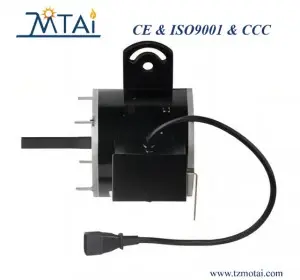Basic structure of induction motor:
1. Basic structure of single-phase asynchronous motor
A single-phase asynchronous motor is a motor that only needs a single-phase AC power supply. Single-phase asynchronous motor consists of stator, rotor, bearing, casing, end cover, etc. The stator consists of a frame and an iron core with windings. The iron core is made of silicon steel sheets punched and laminated in grooves. Two sets of main windings (also called running windings) and auxiliary windings (also called starting windings forming auxiliary windings) spaced 90° apart are embedded in the grooves. The main winding is connected to the AC power supply, and the auxiliary winding is connected in series to the centrifugal switch S or starting capacitor, running capacitor, etc., and then connected to the power supply. The rotor is a cage-type cast aluminum rotor. The iron core is laminated and then aluminum is cast into the slot of the iron core. The end rings are also cast together to short-circuit the rotor guide bars into a squirrel-cage type.
Single-phase asynchronous motors are further divided into single-phase resistance-start asynchronous motors, single-phase capacitor-start asynchronous motors, single-phase capacitor-run asynchronous motors and single-phase dual-value capacitor asynchronous motors.
2.Basic structure of three-phase asynchronous motor
Three-phase asynchronous motor mainly consists of stator, rotor and bearings. The stator is mainly composed of iron core, three-phase winding, frame and end cover. The stator core is generally punched and laminated from 0.35~0.5 mm thick silicon steel sheets with an insulating layer on the surface. There are evenly distributed slots punched in the inner circle of the core to embed the stator windings. The three-phase winding is composed of three windings with the same structure that are spaced 120° apart from each other and arranged symmetrically. Each coil of these windings is embedded in each slot of the stator according to certain rules. Its function is to pass in three-phase alternating current and generate a rotating magnetic field. The base is usually made of cast iron. The base of large asynchronous motors is generally welded with steel plates. The base of micro motors is made of cast aluminum. Its function is to fix the stator core and front and rear end covers to support the rotor, and play a role in protection and heat dissipation. There are heat dissipation ribs on the outside of the base of the enclosed motor to increase the heat dissipation area. The end covers at both ends of the base of the protected motor have ventilation holes to allow direct convection of air inside and outside the motor to facilitate heat dissipation. The end cover mainly plays the role of fixing the rotor, supporting and protecting it. The rotor is mainly composed of iron core and windings.
The rotor core is made of the same material as the stator. It is punched and laminated from 0.5 mm thick silicon steel sheets. The outer circle of the silicon steel sheets is punched with evenly distributed holes for placing the rotor windings. Usually, the inner circle of the silicon steel sheet punched out from the stator core is used to punch the rotor core. Generally, the rotor core of small asynchronous motors is directly pressed on the rotating shaft, while the rotor core of large and medium-sized asynchronous motors (rotor diameter is more than 300~400 mm) is pressed on the rotating shaft with the help of a rotor bracket.
Post time: Jan-16-2024









